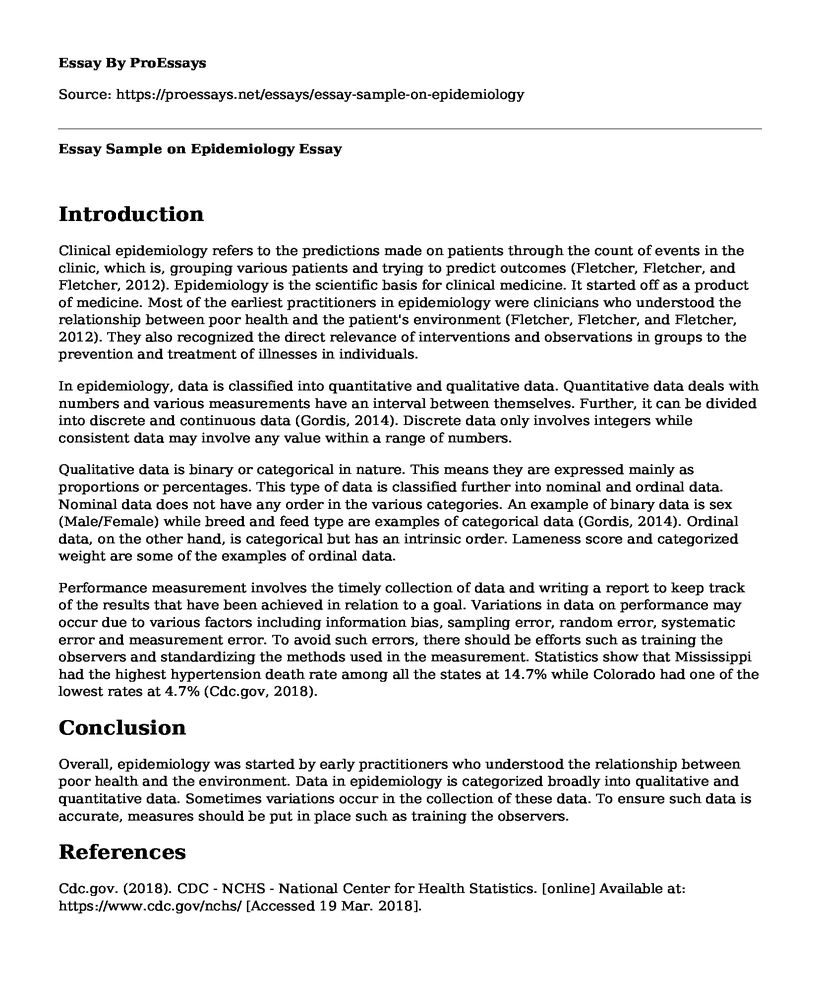Introduction
Clinical epidemiology refers to the predictions made on patients through the count of events in the clinic, which is, grouping various patients and trying to predict outcomes (Fletcher, Fletcher, and Fletcher, 2012). Epidemiology is the scientific basis for clinical medicine. It started off as a product of medicine. Most of the earliest practitioners in epidemiology were clinicians who understood the relationship between poor health and the patient's environment (Fletcher, Fletcher, and Fletcher, 2012). They also recognized the direct relevance of interventions and observations in groups to the prevention and treatment of illnesses in individuals.
In epidemiology, data is classified into quantitative and qualitative data. Quantitative data deals with numbers and various measurements have an interval between themselves. Further, it can be divided into discrete and continuous data (Gordis, 2014). Discrete data only involves integers while consistent data may involve any value within a range of numbers.
Qualitative data is binary or categorical in nature. This means they are expressed mainly as proportions or percentages. This type of data is classified further into nominal and ordinal data. Nominal data does not have any order in the various categories. An example of binary data is sex (Male/Female) while breed and feed type are examples of categorical data (Gordis, 2014). Ordinal data, on the other hand, is categorical but has an intrinsic order. Lameness score and categorized weight are some of the examples of ordinal data.
Performance measurement involves the timely collection of data and writing a report to keep track of the results that have been achieved in relation to a goal. Variations in data on performance may occur due to various factors including information bias, sampling error, random error, systematic error and measurement error. To avoid such errors, there should be efforts such as training the observers and standardizing the methods used in the measurement. Statistics show that Mississippi had the highest hypertension death rate among all the states at 14.7% while Colorado had one of the lowest rates at 4.7% (Cdc.gov, 2018).
Conclusion
Overall, epidemiology was started by early practitioners who understood the relationship between poor health and the environment. Data in epidemiology is categorized broadly into qualitative and quantitative data. Sometimes variations occur in the collection of these data. To ensure such data is accurate, measures should be put in place such as training the observers.
References
Cdc.gov. (2018). CDC - NCHS - National Center for Health Statistics. [online] Available at: https://www.cdc.gov/nchs/ [Accessed 19 Mar. 2018].
Fletcher, R. H., Fletcher, S. W., & Fletcher, G. S. (2012). Clinical epidemiology: the essentials. Lippincott Williams & Wilkins.
Gordis, L. (2014). Epidemiology. Philadelphia, Pennsylvania: Elsevier Saunders.
Cite this page
Essay Sample on Epidemiology. (2022, Apr 07). Retrieved from https://proessays.net/essays/essay-sample-on-epidemiology
If you are the original author of this essay and no longer wish to have it published on the ProEssays website, please click below to request its removal:
- Tobacco as a Health Issue Essay
- Analysis of Sources on Youth Risk Behavior Paper Example
- Targeting Isocitrate Lyase (ICL) For the Treatment of Talent Tuberculosis
- Essay Sample on Community Health Systems
- Essay on Smoking Ban in Public Housing Violates Rights: HUD Authority Questioned
- Essay Example on GM Crops: Impact on Food Security?
- Essay Example on Washington DC: Booming Biomedical Research & Healthcare Hub







